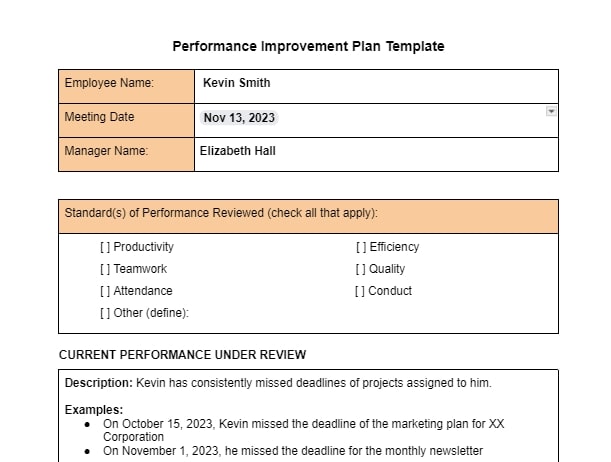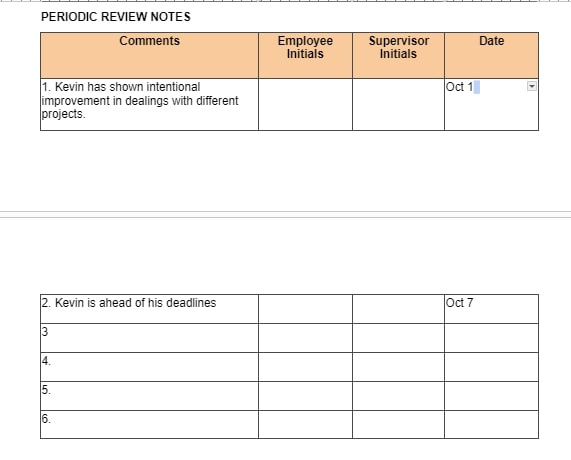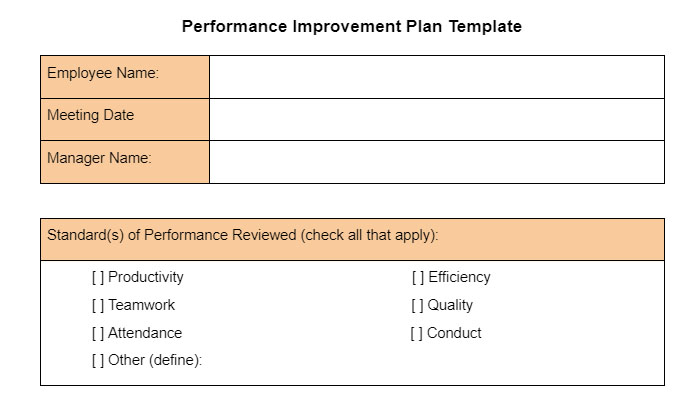A performance improvement plan (PIP) is a management tool for creating a roadmap to help an underperforming employee succeed. Whether an employee is failing to meet their objectives or has excessive tardiness that must be corrected, a PIP provides a structured path for strengthening their performance. After you’ve determined that a PIP is appropriate, you’ll need to identify the needed improvements, define performance goals, and determine a timeline for completion. Download our free performance improvement plan template to get started.
Want to use a PIP tool that’s less manual? HR management software, like BambooHR, can help managers create a performance improvement plan with its customizable templates. It also offers goal-setting and tracking features, helping managers provide regular feedback and address concerns immediately and efficiently.
Use the following steps to create your own PIP:
Step 1: Determine if a PIP Is Appropriate
A performance improvement plan is just one tool within your employee management process, which is why it’s important to determine whether it is appropriate in the given situation. It should only come after you’ve had conversations with the employee about their performance or workplace behaviors and taken the initial steps to help them improve. Employees should not be surprised or caught off guard by the PIP, as it can lead to legal problems.
It’s also good practice to make this determination in consultation with HR, as they can ensure that you remain compliant and are using a company-approved PIP. They can also help you discuss the plan with the employee, taking some discomfort off your shoulders.
Consider these questions before developing a PIP:
Is the problem that your employee isn’t meeting objective quantitative goals, or is it that their behavior or attitude is disrupting the team dynamic? If it’s the latter, a PIP may not be the right solution. Behavior and attitude problems are often better addressed through coaching and counseling.
If the problem is relatively new, it may just be a matter of getting your employee back on track. In this case, a PIP can help them understand what they need to do to meet your expectations. On the other hand, if the problem has been going on for months or even years, it may be time to consider other options, such as termination, provided that you’ve given them an opportunity and support to improve.
If you’ve already talked to your employee about the problem and discussed potential solutions, but nothing has changed, then a PIP may be appropriate. However, if you haven’t done anything yet to address the issue, then a PIP probably won’t help—and may even make things worse. You must first take other corrective actions before enacting a PIP.
Are you realistic in your expectations for how much improvement you want to see from your employee? If not, then a PIP is likely to do more harm than good. Remember, the goal of a PIP is to help an employee improve—not punish them for their failings.
A PIP can only be successful if you’re willing to provide support throughout the process. This means regular check-ins with your employee, clear and concise feedback, and access to resources they may need to succeed. If you’re not prepared to do this, then don’t bother with a PIP—it won’t work.
If the answer to this question is yes, then a PIP may not be necessary. The issue could be resolved with some targeted coaching and feedback. But if the problem is widespread, affecting multiple areas of the job, then a PIP may be the best course of action.
It’s important to be honest with yourself about your motivation for putting an employee on a PIP. If your motivation is purely punitive, then a PIP is not appropriate. But if your motivation is genuinely to help the employee improve their performance, then a PIP may be warranted.
Step 2: Identify Improvements Needed
Once you’ve determined that a PIP is appropriate, it’s time to create the plan. Make sure you provide adequate details to show why the employee’s present performance is deficient and what specifically they need to do to improve.
I recommend attaching the job description to the PIP you’re preparing. This reminds the employee of the minimum requirements for the job they hold and can help you ensure that you’re holding the employee accountable to their stated duties.
These areas for improvement should come directly from the manager’s previous notes about the employee’s performance, which may have been discussed in previous performance reviews. If the employee hasn’t been made aware of any issues, I do not recommend putting them on a PIP as the first course of action. Always discuss issues with employees in real time, if possible, or at least during regular check-ins. These check-ins will also give managers documented evidence of how long the employee has been underperforming and what steps have been taken so far.
Here’s what this might look like in practice:

A preview of a filled PIP document for an underperforming marketing staff member
Compliance tip: Always use a PIP template to ensure you treat each plan and all employees the same. This can help your company avoid legal trouble by removing the appearance of discrimination.
Step 3: Define PIP Goals
Now that you know where an employee needs to improve, it’s time to set the goals for how they achieve success. Just like you set goals for departments and employees, you should also set goals in the PIP using the same method. I recommend using SMART goals: Specific, Measurable, Achievable, Relevant, Time-bound. Setting these goals can be easier with a performance management system.
You don’t want to have a ton of goals listed on the PIP which could overwhelm an employee and make them feel you’re setting them up for failure. Choose one to three key goals that your employee needs to focus on and provide them with the structure needed to achieve the goals.
Let’s say you have an employee who missed key deadlines on the last two projects they were assigned. You discussed this performance issue with them after each project deadline was missed and tried to help, but they haven’t improved. The employee has another project coming due in a few months, and you want to make sure they meet the deadline. Here’s how you might structure your SMART goals in the PIP:
- Specific: Project X will be completed accurately and on time.
- Measurable: Using key milestones, the employee will meet a Project X deadline of April 30.
- Achievable: By defining milestones and reviewing steps, Project X will be set up for a successful on-time completion within the reasonable time period provided.
- Relevant: Milestones will be built in coordination with the manager and all team members.
- Time-bound: Project X will be completed by April 30.
Now let’s put it all together: Project X will be completed accurately and by the April 30 deadline by setting up and hitting key milestones to ensure the project is on pace.
Ultimately, you’re trying to help the employee achieve success and come off the PIP.
Did you know? A recent study revealed that unrealistic time frames are one of the top causes of employee burnout. Setting unrealistic deadlines for your employees is akin to setting them up for failure.
Step 4: Structure Timeline
Using SMART goals to structure your PIP will help you create the timeline for completion. But you need to set more than just the end date for the plan, which I recommend setting to align with the performance you’re looking to improve.
In our example, this deadline would need to align with the Project X completion date of April 30. However, it’s perfectly reasonable to set a PIP timeline of 90 days, six months, or whatever timeline works for the situation at hand. Above all, the timeline needs to be reasonable.
You also need to set checkpoints throughout the PIP; this is not merely a document you create, discuss with the employee, and then let them navigate alone. As a manager, you need to be prepared to work with the employee to give them every opportunity for success. That means setting aside regular check-in times to answer questions and guide them.
Step 5: Speak With the Employee & Provide Support
When it’s time to review the PIP with the employee, I recommend having HR present to help document the conversation. Having another person present will keep the conversation on point.
By expressing your desire to help the employee succeed, you can set the tone for a fruitful conversation. During this meeting, you should also encourage the employee to speak openly and suggest any changes to the PIP. Perhaps they have ideas on how to be successful or may need to ask clarifying questions. Either way, giving them the time to be heard shows them you value their input.
In your discussion with the employee, outline the support you will provide. This should include regular project meetings to ensure the pace of the project is on track and key milestones are being met. Be prepared to assist the employee with any issues that arise.
Step 6: Have Everyone Sign
You must have the employee sign the PIP, acknowledging they understand the goals they need to achieve. You should also sign it, attesting to the details contained and acknowledging that you will provide necessary support to the employee.
It’s also good practice to have HR sign the PIP to acknowledge they have reviewed the plan and find it reasonable and achievable.
Step 7: Monitor Progress
This is a key component to any successful PIP. If you let an employee go off on their own, they will be destined for failure. However, by guiding them and helping them hit little goals, you can help them achieve the overall goals of the PIP and reach a successful outcome.
As a manager, you need to show your commitment to the employee. You do this by prioritizing them, keeping scheduled check-ins, and being present to help them succeed. Each check-in should be used to celebrate even small wins, motivating the employee to continue their improvement.
Here’s how that might look:

A preview of each summarized PIP check-in, including the date these check-ins occurred.
Step 8: Conclude PIP
Hopefully, this is a celebratory affair. As long as the employee meets the stated objectives of the PIP by the deadline, or sooner, the PIP is deemed successful. Both you and the employee should sign off on the PIP, concluding the plan. Make sure the employee understands that their improved level of performance is expected to continue.
Not all performance improvement plans end successfully, however. If an employee is unable to complete the goals outlined in the PIP and has been given support by their manager, demoting or terminating the employee may be the next step.
Nonetheless, if an employee has shown improvement and motivation but was unable to meet all of the goals, you might extend the deadline. If you look back at the PIP and see, in retrospect, the timeline and goals were not realistic and might have been too aggressive, adjusting the timeline is perfectly acceptable to give the employee every chance at success.
Pro Tip: A solid performance management system can help you create and track performance improvement plans efficiently. Check out our top performance management system picks for the best options.
Legal Considerations
Before putting an employee on a PIP, you must be aware of the legal considerations to ensure that you comply with employment laws and spare the organization from potential legal claims.
Some of the key aspects to consider are:
- Non-discrimination and objectivity: The criteria you use should always be objective. Do not use vague or subjective language. Instead focus on specific performance issues.
- Fair and equal treatment: Follow your policies every single time. Treat employees the same. When you deviate from your policies or treat employees in similar situations differently, you risk allegations of discrimination and workplace mistreatment. This can quickly lead to employee lawsuits and government penalties.
- Documentation and communication: Document at least one conversation with the employee and what actions they need to take to improve their performance. This is crucial because you need to give employees opportunities to improve—and you must be able to prove that you did so legally.
- Resources and support: You can’t simply tell them to improve and provide no support. By having frequent discussions, and addressing poor performance in the moment, you ensure you build documentation showing everything you’ve done to help.
- Confidentiality and non-retaliation: Protect your employee’s privacy. Never discuss their performance issues to unauthorized personnel, much more people outside the workplace. Additionally, don’t use the PIP as a form of retaliation against an employee.
Pros and Cons of a Performance Improvement Plan
Like any HR tool, performance improvement plans come with their share of positives and negatives that should be considered before you decide to put one into effect. Consider the following:
| PROS | CONS |
|---|---|
| Reassures employees that they are given an opportunity to improve | Can become time-consuming |
| Allows employees to take ownership | Could produce uncomfortable conversations |
| Reduces turnover | Can disrupt regular workflow |
| Addresses performance issues immediately | Employees could misinterpret it as a prelude to termination |
| Promotes transparency within the organization | |
The PIP process can either have a negative or a positive impact on an employee, depending on the way you handled it and when it was conducted. Thus, you need to discern when it would be beneficial or not.
Handling PIPs Frequently Asked Questions (FAQs)
Should I immediately terminate an employee for poor performance?
Aside from the legal issues mentioned in a section above this article, terminating an employee immediately isn’t addressing any underlying issue that causes the poor performance. By having a performance improvement plan in place, you not only give employees a chance to improve but it also reduces turnover. This saves the company time, money, and effort associated with hiring and training new employees.
What are the things to avoid when writing a performance improvement plan?
Avoid biases, ambiguous targets, and unrealistic deadlines when creating a PIP. They could demotivate employees and affect their productivity. Some of the biases you need to look out for are leniency and severity biases. These are opposite biases where you either rate an employee more or less than they deserve.
Bottom Line
Employees who do not meet company expectations may need to be put on a PIP. A well-structured and implemented plan creates a culture of development and investment in your employees, which can lead to more engagement and higher productivity from your team. Utilizing our free PIP template and following the steps outlined here, you can create a personalized plan that illustrates exactly what your employee needs to improve, giving them the support and guidance they need to successfully achieve the set goals.
Employees often think of a PIP as a precursor to termination. While that can certainly occur, make sure you are transparent with your employees and reassure them that a PIP helps them get back on the right track.
